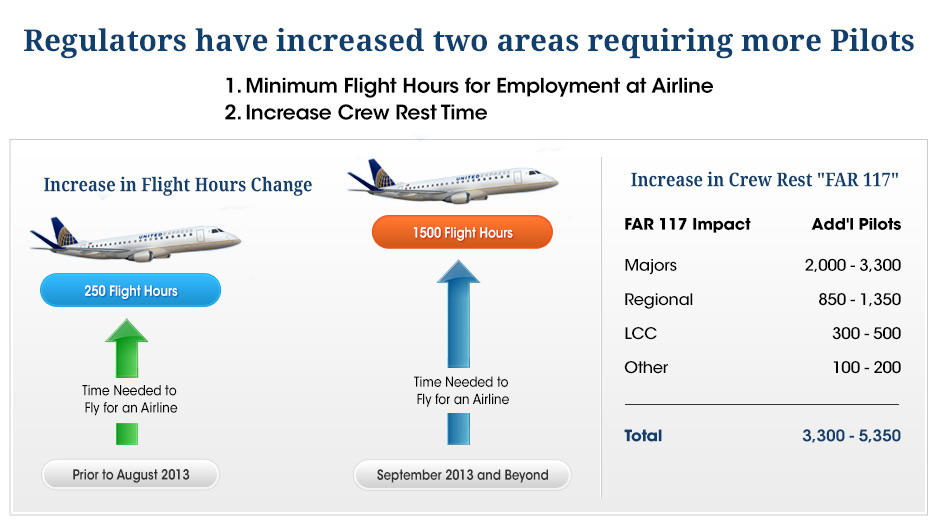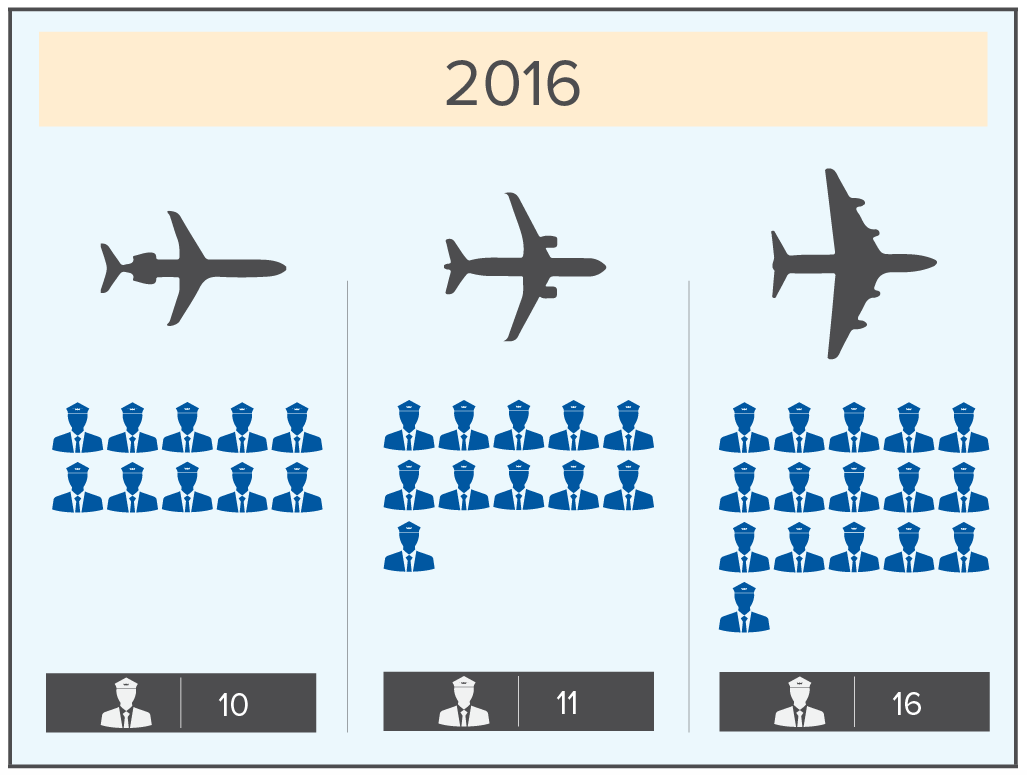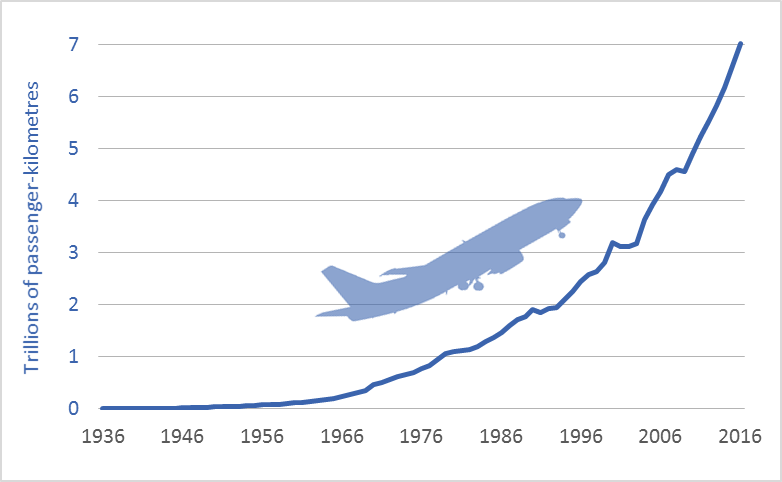Introduction
The shortage of highly experienced experts is a major issue in the aviation sector. According to Kaplan and Collier (2014), the new aviation policy that requires pilots to clock 1500 hours in the air to be considered qualified to fly large commercial planes has worsened the already bad situation. Pilots who have recently graduated from flying schools have to go through additional training to be able to control commercial planes.
Choy (2014) notes that one of the issues that have led to the shortage of pilots at a global level is a relatively low pay compared to what they expect when they graduate from flying schools. As such, some of them consider pursuing other careers after working in the aviation sector for several years. When an airline loses a professionally trained and experienced employee, finding a replacement with similar qualifications may not be easy.
In fact, some large airline companies are straining to meet the demand of their clients because of the shortage of pilots. It is projected that if the current trend continues, the problem is likely to deteriorate within the next five years. Senior management units of local airline companies have to find ways of addressing this problem. The aviation sector is under significant pressure to find enough qualified personnel. This paper will focus on finding the best ways in which executives in this industry can combat the lack of aviation professionals.
Analysis of Findings
The shortage of pilots and other aviation experts, such as air traffic controllers, engineers and aviation managers, is a complex problem that is caused by different factors. Some of the changes in the industry have taken place so rapidly that stakeholders have not been able to determine how to cope with them. As Choy (2014) notes, one of the major changes that have been witnessed in the aviation industry is an increase in the minimum flight hours and crew rest time necessary for employment in the airline industry. As shown in figure 1 below, pilots only needed 250 flight hours to fly for an airline in August, 2013.
A month later, in September, 2013, a new policy was introduced stating that pilots were required to have 1500 flight hours to fly a commercial plane. The drastic change of policy meant that many aviation experts who were working for different airlines around the world were rendered unqualified to fly commercial planes. Consequently, airlines had to struggle to find their replacement. Another major change was an increase in crew rest time.

The changes had to be implemented immediately for an airline to be considered compliant. When the crew has to be granted more time to rest, the airline has to hire more pilots to ensure that operations continue uninterrupted when some of the crewmembers are having their rest. A new trend has also emerged where airlines are using large aircrafts, especially for destinations where the number of travellers is high.
Choy (2014) explains that the larger the plane is, the higher is the number of crewmembers needed to operate it. For instance, an Airbus A380 will require a ratio of 16 pilots to one plane if it is to be operated at an optimum level. It means that when airlines move from using small aircrafts to large planes, they will need a greater number of qualified crewmembers to facilitate their operations.

The growing number of passengers using air transport has compounded the problem of the shortage of experts in the aviation sector. As shown in figure 3 below, the number of passengers using air transport has been consistently increasing for the last several years. Improved living standards, a rise in the number of the middle class and the relatively low cost of flights are some of the factors that have led to more people using air transport. As Choy (2014) observes this change means that airlines need to hire more pilots and other aviation experts to meet the demand for services in this industry.

Factors Limiting the Growth of the Number of Pilots Proportionate to Their Demand
The growth of air transport market over the last several years indicates that the industry needs more pilots, engineers, air traffic controllers and aviation managers. However, Choy (2014) reports that the growth in the number of these experts does not properly correlate with the increase in the number of passengers. It is true that the number of pilots today is greater than it was one or two decades ago. However, it is relatively lower than market demand. The following are the main factors that stakeholders and scholars have identified as the leading causes of the shortage of licensed qualified pilots.
High Cost of Training
One of the main factors that limit the growth in the number of pilots is the cost of training. The average cost of 4-year actuarial science training in the United States is $75,000 (Kaplan & Collier 2014). For an engineer, the cost is $44,720, while a law school will require an individual to pay $43,020. At the same time, to train as a pilot may require as much as $151,681 in the United States. Such high cost of training to become a pilot makes the course a preserve of the few rich members of the society. Although an individual may be interested in becoming an aeronaut, the prohibitive cost of education makes it almost impossible to do so. Choy (2014) explains that the price of aviation professionals’ education is not only steep in the United States but also in other parts of the world.
Relatively Low Pay
The fact of how expensive it is to train as a pilot would make one believe that it is one of the best paying jobs in the world. Although the salary of a pilot is above the annual average salary around the world, there are other professions which pay better than being a pilot. Physicians, pharmacists, architects, software developers and lawyers earn relatively higher salaries than employees in the aviation sector, especially those in private practice (Kaplan & Collier 2014). As such, some of the qualified pilots often consider diverting to other careers that they believe are less demanding but more rewarding. The more such experts are lost, the more is the shortage experienced by the industry.
Perceived Risks
The perceived risks in the aviation sector are believed to be other major causes of the shortage in the number of pilots in the aviation industry. According to Choy (2014, p. 73), “statistics show that air transport is the safest means of moving from one place to another.” However, the few accidents that occur in this industry are often given maximum media coverage and public attention because of their magnitude. Chances of surviving a plane crash are always low. The fact that terrorists are currently targeting large commercial planes, as was witnessed in the September 11, 2001 terror attack in the United States and the downing of the Malaysian plane in Ukraine in 2014, has created fear among individuals who could train to become pilots.
Models of Addressing the Shortage
It is the responsibility of managers in major local and international airlines to find solutions to this problem. As the policies that guide airline operations become stricter and the amount of customers increases, finding and retaining an adequate number of highly skilled employees in this industry is critical. It may be necessary to embrace unique models and theory of operations to deal with this problem.
Hackman and Oldham’s Job Characteristics Model
One of the challenges that airlines face is keeping highly qualified and experienced teams of pilots within the company. Hackman and Oldham’s job characteristics model proposes strategies that a firm should embrace to ensure that its top employees remain satisfied and keen on staying in the firm (Kaplan & Collier 2014). According to this model, boredom and monotony are some of the main factors that may make an employee consider moving to other firms or careers.
As such, it proposes various ways of breaking the monotony. It encourages firms to regularly organise events that take workers away from their normal routines and let them have thrilling experiences. Sometimes, it may be necessary to redefine their tasks at work and create new challenges that they would want to overcome as a sign of career growth. Although this model demonstrates a non-monetary approach to motivating employees, Arvai and Schonland (2017, p. 56) argue that firms should not “ignore the need to pay their employees attractive salaries.” A pay raise may be a proper motivation for an employee to consider remaining in a firm.
Dispositional Theory
Dispositional theory, also known as trait theory, is the study of human personality (Kaplan & Collier 2014). It acknowledges the fact that people are unique, and understanding this uniqueness is critical for ensuring that they remain motivated and committed to their work. The theory classifies people into two broad groups of extraverts and introverts. It encourages executives to make an effort to understand the unique traits of every employee, especially the highly talented workers that a firm cannot afford to lose (Choy 2014). The firm should then develop ways of fulfilling their specific needs to make them loyal and committed to their employer. The goal is to ensure that these employees feel respected and valued by their company.
Managing Stress
Studies show that working as a pilot is one of the most stressful jobs in the world. The fact that the lives of over two hundred people are trusted to two pilots and that a small mistake or a technical error may have catastrophic consequences can be emotionally draining. Sometimes, these employees have to deal with rude passengers on their planes, tight schedules and poor weather conditions (AirInsight 2014). Some of them may be stressed and may consider other less demanding careers. It is necessary for every airline company to have counselling sessions for crewmembers and other strategies of handling stress. Mechanisms should be put in place to identify pilots who may show signs of stress when they are at work.
Training Schools
The above models and theories are meant to retain talented pilots in a given airline. However, it is equally important for a firm to find such talents before making sure it can keep them. One of the steps that companies can take to hire talented professionals is to have a flying school. Virgin Atlantic, one of the leading airline companies in the world, has established its own flying school (Bridges, Neal-Smith & Mills 2014).
Royal Jordanian Airlines, the flag carrier airline of Jordan, also has its own flying school. Having a flying school makes it easy to spot talented pilots who can help the firm to achieve goals in the aviation market. Sometimes, an airline company with its own flying school can reach an agreement with its trainees, which is mutually beneficial to both parties. One of the main barriers to having enough qualified experts is the high cost of training.
Airlines can sponsor some of the best talents to train as pilots. Under such conditions, the student will sign an agreement that commits them to the firm for a specific period, preferably for ten years. Within that period, such pilots will not consider working for any other firm. When using such a strategy, Kaplan and Collier (2014) warn that a firm should avoid making such employees feel imprisoned. They should have a good working environment and attractive pay that would make them willing to stay within the firm even after the expiry of the agreement.
Conclusion and Recommendations
The rapid growth of air transport is a sign of improved living standards in various parts of the world. The increasing need for people to move from one country to another has made the aviation sector one of the most critical industries in the modern society. Despite the attractive growth of the market, studies show that the number of pilots and other aviation personnel such as air traffic controllers, engineers and aviation managers has not increased proportionally.
Some airlines have been operating below their capacity because of the shortage of pilots. In such a highly competitive industry, firms cannot afford to lower their rate of operations at a time when the demand for their services is great. Failing to meet the needs of customers as promised may lead to dissatisfaction. An unhappy customer would consider using other airline companies in the future when they plan to travel.
As such, it is critical for local airline companies to find ways of tackling the problem of the approaching shortage of personnel in this industry. The statistics show that this concern may become worse within the next five years. Every firm should invent unique ways of coping with this situation to enhance their sustainability in the market. The following are the recommendations that they should take into account to overcome the problem:
- Local airline companies should consider offering their pilots attractive salaries as a strategy to retain them in the firm. One of the leading reasons for pilots and other aviation personnel to think of working for other airlines in Europe, North America and the Middle East is the issue of poor pay among local airlines. Increasing their salaries will make these firms competitive regionally and internationally.
- Airline companies need to find ways of fighting stress and boredom at work. Mechanisms should be put in place that would make it easy for pilots to seek counselling services when they are stressed. Their work should be designed in a manner that minimises boredom.
- Top executives in the local aviation industry should develop plans of continued growth and development among pilots. A guideline should be developed that outlines how crewmembers should undergo regular training to improve their competence.
Reference List
AirInsight 2014, Evolutionary dynamics of the regional airline industry, AirInsight, New York, NY.
Arvai, ES & Schonland, AM 2017, Bombardier’s CRJ: rumours of its demise are greatly exaggerated, AirInsight, New York, NY.
Bridges, D, Neal-Smith, J & Mills, AJ (eds.) 2014, Absent aviators: gender issues in aviation, Ashgate, Burlington, VT.
Holleran, RS, Philip, L & Soucie, D 2017, Bracing for impact: true tales of air disasters and the people who survived them, Skyhorse Publishing, La Vergne, TN.
Choy, PM 2014, The flying dragon, Xlibris LLC, New York, NY.
Kaplan, P & Collier, R 2014, The few: fight for the skies, rare photographs from wartime archives, Pen & Sword Military Aviation, South Yorkshire.